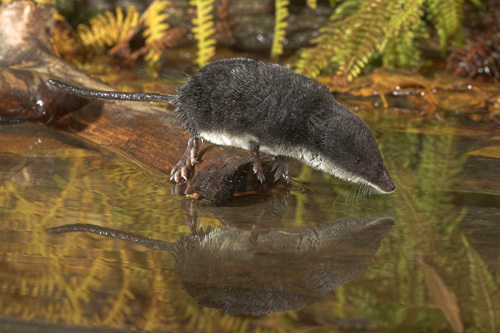References
Animal Diversity Web: ADW 2013. <URL:
http://animaldiversity.ummz.umich.edu/accounts/Neomys_fodiens/>.
Accessed 25 April 2013
Churchfield, S. J, Barber., and C, Quinn.
2000. A new survey method for Water Shrews (Neomys
fodiens) using baited tubes. Mammal review 30.3-4:249-254.
Cuenca-Bescós,G., and J. Rofes. 2007. First evidence of poisonous
shrews with an envenomation apparatus. Naturwissenschaften
94.2: 113-116.
Encyclopedia of Life 2013. <URL:
http://eol.org/pages/1178936/overview>. Accessed 25 April 2013.
Grzimek, B. 1990. Grzimek's
Encyclopedia of Mammals. McGraw-Hill Publishing, New York,
New York,
USA.
Gupta, R.C. 2012.
Veterinary Toxicology: Basic and Clinical Principles.
Elsevier Publishing, London, UK.
Haberl, W. 2002. Food storage, prey remains and notes on occasional
vertebrates in the diet of the Eurasian water shrew,
Neomys fodiens. Folia
zoologica 51.2:93-102.
Hanski, I. 1989. Population biology of Eurasian shrews: towards a
synthesis. Annales Zoologici Fennici. Vol. 26. Societas Biologica Fennica
Vanamo.
Karbowiak, G., I. Wita, and L. Rychlik. 2005.
Trypanosoma (Megatrypanum)
ornata sp. n., a parasite of the Eurasian Water Shrew
Neomys fodiens (Pennant,
1771). Acta protozoologica 44: 363-367.
Kita, M., et al. 2004. Blarina toxin, a mammalian lethal venom from
the short-tailed shrew Blarina brevicauda: isolation and
characterization. Proceedings of the National Academy of Sciences of the United
States of America 101.20: 7542-7547.
Krushinska, N. L., and Z. Pucek. 1989. Ethological study of
sympatric species of European water shrews.
Acta Theriologica
34: 269-285.
Michalak, I. 1983. Reproduction, maternal and social behaviour of
the European water shrew under laboratory conditions.
Acta Theriologica
28.1: 3-24.
Rychlik, L.1997. Differences in foraging behaviour between water
shrews:
Neomys anomalus
and Neomys fodiens.
Acta Theriologica
42.4.
Scott, D.M., F.Southgate, A.J.Overall, S. Waite, and B.A. Tolhurst.
2012. The Eurasian water
shrew: an
unsuitable candidate species for a vertebrate bio-indicator of
aquatic pollution. Journal of zoology 286.1:30-37.
Wilson, D. E. and D.M. Reeder. 2005. Mammal Species of the World: A
Taxonomic and Geographic Reference.
Johns Hopkins University Press, Baltimore,
Maryland, USA.
